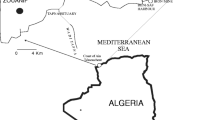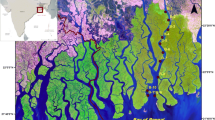Abstract
The concentrations of Cd, Cu, Mn, Ni, Pb, Fe and Zn were determined in superficial sediments extracted from nine zones of Budi Lagoon, located in the Araucanía Region (Chile). The concentrations of these metals were determined by flame atomic absorption spectroscopy and the method was validated using certified reference material (marine sediment). The concentration ranges found for the trace elements were: Pb < 0.5; Cd < 0.2–3.9; Cu 21.8–61.9; Ni 31.2–59.4; Zn 54.5–94.8 mgkg−1 (dry weight). The elements that registered the highest concentrations were Mn 285.4–989.8 mgkg−1 and Fe 4.8–10.6 %. The lagoon cluster analysis of the stations was divided into three groups (Temo station with high Cu and low Mn concentrations, Bolleco, Comué, Allipén and Deume 3 stations presented highest Cd concentration, and another group Botapulli, Río Budi, Deume 2 and Deume 1 stations presented low levels of Cd). The textural characteristics of the sediment were determined (gravel, sand and mud) and the results were correlated with the concentrations of the metals in the various study zones. The sediments of Budi Lagoon presented high levels of Fe and Mn, which are of natural origin and exceed the maximum values recorded by many authors. With respect to the recorded concentrations for Cd, Cu, Ni and Zn, are within the ranges published by other authors in similar works. The Pb element was not detected. The results were subjected to statistical analysis to evaluate the correlations between the content of the elements and obtain the site of sediment.




Similar content being viewed by others
References
Alam MGM, Tanaka A, Allison G, Laureson LJB, Stagnitti F, Snow ET (2002) A comparison of trace element concentration in cultured and wild carp (Cyprinus carpio) of lake Kasumigaura, Japan. Ecotox Environ Safe 53:348–354
Baird C (2001) Química Ambiental. University of Western Notario. Ed Reverté 7:391–429
Baisch PRN (1988) Metals in coastal environments of Latin America. Springer, Heidelberg-Berlin, pp 59–63
Barquero-Quirós M, Vargas-Rojas R, Blanco-Sáenz R (2001) Neurotoxicidad y enfermedades óseas provocadas por la contaminación con aluminio de soluciones de diálisis renal. Rev Costarric Cienc Med 22:3–4
Bellucci LG, Frignania M, Paoluccib D, Ravanellia M (2002) Distribution of heavy metals in sediments of the Venice Lagoon: the role of the industrial area. Sci Total Environ 295:35–49
Bertrán C, Vargas-Chacoff L, Peña-Cortés F, Mulsow S, Tapia J, Hauenstein E, Schlatter R, Bravo A (2006) Macrofauna bentónica de los humedales de tres lagos salinos en el borde costero del sur de Chile. Cienc Mar 32:589–596
Bertrán C, Vargas-Chacoff L, Peña-Cortés F, Schlatter R, Tapia J, Hauenstein E (2010) Distribución de la macrofauna bentónica en el lago costero Budi, Sur de Chile. Rev Biol Mar Oceanog 45:235–243
Bradl H, Kim C, Kramar U, Stüben D (2005) Interactions of heavy metals, en: Bradl H (ed) Heavy metals in the environment: origin, interaction and remediation, vol 6. Elsevier, Amsterdam, pp 28–164
Carrol P (1958) Role of clay minerals in transportation of iron. Geochim Cosmochim Ac 3:9–60
Chiang J (1988) Contaminación del mar y el futuro de la pesca en Chile. Revista Ambiente y Desarrollo 4:67–72
Clarke KR, Warwick RM (1994) Similarity based testing for community pattern: the 2-way layout with no replication. Mar Biol 118:167–176
De Gregori I, Delgado D, Pinochet H, Gras N, Thieck M, Muñoz L, Bruhn C, Navarrete G (1992) Toxic trace elements in chilean seafoods development of analytical quality control procedures. Sci Total Environ 3:201–208
EC (2006) Commission Regulation No. 1881/2006 of 19 December 2006, Official Journal of European Communities L 364/5
Eisler R (1988) Zinc hazards to fish, wildlife and invertebrates: a synoptic review. US Fish Wildl Ser Biology Reprod, p 85
El-Hasan T, Jiries A (2001) Heavy Metal Distribution in Valley Sediments in Wadi Al-Karak Catchment Area, South Jordan. Environ Geochem Health 23:105–116
El-Hasan T, Szczerba W, Radtke M, Riesemeier H, Buzanich G, Kersten M (2011) Cr(VI)/Cr(III) and As(V)/As(III) ratio assessments in Jordanian spent oil shale produced by aerobic combustion and anaerobic pyrolysis. Environ Sci Technol 45:9799–9805
Förstner U, Wittman GTW (1979) Metal pollution in the aquatic environment, Ed. Springer-Verlag: Berlin-Heidelberg-New York, 486 S., 102 Abb., 94 Tab
Förstner U, Wittman GTW (1981) Metal pollution in the aquatic environment. Springer, Berlin
Franc S, Vinagre C, Caçador I, Henrique CN (2005) Heavy metal concentrations in sediment, benthic invertebrates and fish in three salt marsh areas subjected to different pollution loads in the Tagus Estuary (Portugal). Mar Poll Bull 50:993–1018
Gobert S, Daemers-Lambert C, Bouquegneau JM (1992) Etat physiologique et contamination en Metaux Lourds des Moules Mytilus edulis Sur La Cote Belge. Bull Soc Roy Sci Liège Proc Roy Soc 61:177–194
González E, Gainza-Cortés F, Pérez-Díaz R, Pérez-Castro R, Tapia J, Casaretto J, González S, Peña-Cortés H, Ruiz-Lara S (2012) Characterization of a putative grapevine Zn transporter, VvZIP3, suggests its involvement in early reproductive development in Vitis vinifera L. BMC Plant Biol 12:111
Hamed MA (1998) Distribution of trace metals in the River Nile ecosystem, Damietta branch between Mansoura city and Damietta Province. J Egypt Ger Soc Zool 27:399–415
Herut B, Sandler A (2006) Normalization methods for pollutants in marine sediments: review and recommendations for the Mediterranean Basin. In: F. R. s. t. UNEP/MAP (ed) Research Report H18/2006. Israel Oceanographic and Limnological, p 22
Jennett JC, Effler SW, Wixson BG (1980) Movilization and toxicological aspects of sedimentary contaminants. In: Baker RA (ed) Contaminants and sediments, vol 1. Ann Arbor Science Inc, Michigan, p 429
Kabata-Pendias A, Pendias H (2000) Trace elements in soils and plants, 3rd edn. CRC Press, Boca Ratón, EEUU 432
Klake RK, Nartey VK, Doamekpor LK, Edor K (2012) Correlation between heavy metals in fish and sediment in Sakumo and Kpeshie lagoons, Ghana. J Environ Protect 3:1070–1077
Kouadio I, Trefry JH (1987) Sediment trace metal contamination in the Ivory Coast, West Africa. Water Air Soil Pollut 32:145–154
Langard S, Vigander T (1982) Ocurrence of lung cancer in worker producing chromium pigments. Brit J Ind Med 40:71–74
Leonard A, Lauwerys RR (1980) Carcinogenicity and mutagenicity of Chromium. Mutat Res 76:227–239
Maanan M, Zourarah B, Carruesco C, Aajjane A, Naud J (2004) The distribution of heavy metals in the Sidi Moussa lagoon sediments (Atlantic Moroccan Coast). J Afr Earth Sci 39:473–483
Marcovecchio JE (2004) The use of Micropogonias furnieri and Mugil liza as bioindicators of heavy metals pollution in La Plata river estuary, Argentina. Sci Total Environ 323:219–226
Mendil D, Uluozlu OD (2007) Determination of trace metal levels in sediment and five fish species from lakes in Tokat, Turkey. Food Chem 101:739–745
Narayana AC, Priju CP (2007) Heavy and trace metals in Vembanad lake sediments. Int J Environ Res 1:280–289
Nimmo DR, Willox MJ, Lafrancois TD, Chapman PL, Brinkman SF, Grene JC (1998) Effects of metal mining and milling on boundary waters of Yellowstone National Park, USA. Environ Manag 22:913–926
Nriega JO, Nieboer E (1988) Chromium in the natural and human environmental. Wiley, New York 44
Páez-Ozuna F (1996) Golfo de México, Contaminación e Impacto Ambiental: diagnóstico y Tendencias. EPOMEX Serie Científica 5:349–361
Page AL, Miller RH, Kenney DR (eds) (1982) Heavy metals determination. In: Methods of soil analysis, Part 2, chemical and microbiological Properties. American Society of Agronomy, Madison, WI, USA, p 8
Rigollet V, Sfriso A, Marcomini A, De Casabianca ML (2004) Seasonal evolution of heavy metal concentrations in the surface sediments of two Mediterranean Zostera marina L. beds at Thau lagoon (France) and Venice lagoon (Italy). Bioresour Technol 95:159–167
Romano S, Mugnai C, Giuliani S, Turetta C, Huu CuN, Bellucci LG, Hoai Nhon D, Capodaglio G, Frignani M (2012) Metals in sediment cores from nine coastal lagoons in Central Vietnam. Am J Environ Sci 8:130–142
Salomons W, Förstner U (1984) Metals in the hydrocycle. Springer, Berlin, p 349
Samir M, Saeed M, Ibrahim S (2008) Assessment of heavy metals pollution in water and sediments and their effect on oreochromis niloticus in the northern delta lakes, Egypt. In: 8th International Symposium on Tilapia in Aquaculture
Sivaperumal P, Sankar T, Viswanathan V, Nair PG (2007) Heavy metal concentrations in fish, shellfish and fish products from internal markets of India vis-avis international standards. Food Chem 102:612–620
Stuardo J, Valdovinos C (1989) Estuarios y lagos costeros: ecosistemas importantes del Chile central. Ambiente y Desarrollo 5:107–115
Tapia J, Vargas-Chacoff L, Bertrán C, Torres F, Pinto R, Urzúa S, Valderrama A, Letelier L (2010) Study of the content cadmium, chromium and lead in bivalve molluscs of the Pacific Ocean (Maule Region, Chile). Food Chem 121:666–671
Tapia J, Vargas-Chacoff L, Bertrán C, Peña-Cortés F, Hauenstein E, Schlatter R, Jiménez C, Tapia C (2012) Heavy metals in the liver and muscle of Micropogonias manni fish from Budi Lake, Araucanía Region, Chile: potential risk for humans. Environ Monit Assess 184:3141–3151
USFDA (1993a) Food and drug administration. Guidance Document for Cadmium in Shellfish. US Department of Health and Human Services, Public Health Service (p 44), Office of Seafood (HFS-416), 200 C Street, SW, Washington, D.C. 20204
USFDA (1993b) Food and drug administration. Guidance document for Chromium in Shellfish. US Department of Health and Human Services, Public Health Service (p 40), Office of Seafood (HFS-416), 200 C Street, SW, Washington, D.C. 20204
USFDA (1993c) Food and drug administration. Guidance document for Lead in Shellfish. US Department of Health and Human Services, Public Health Service (p 45), Office of Seafood (HFS-416), 200 C Street, SW, Washington, D.C. 20204
Yilmaz F, Özdemir N, Demirak A, Tuna AL (2007) Heavy metal levels in two fish species Leuciscus cephalus and Lepomis gibbosus. Food Chem 100:830–835
Acknowledgments
This study was carried out in the framework of FONDECYT Project 1080317 and 1110798. The authors are also grateful to the Environmental Chemistry Laboratory of the Institute of Natural Resources Chemistry, University of Talca, Chile and the Institute of Marine Science and Limnology of the Austral University of Chile, Valdivia, Chile. The authors of this study thank the reviewers for their suggestions which has improved the quality of our manuscript.
Author information
Authors and Affiliations
Corresponding authors
Rights and permissions
About this article
Cite this article
Tapia, J., Vargas-Chacoff, L., Bertrán, C. et al. Accumulation of potentially toxic elements in sediments in Budi Lagoon, Araucania Region, Chile. Environ Earth Sci 72, 4283–4290 (2014). https://doi.org/10.1007/s12665-014-3324-4
Received:
Accepted:
Published:
Issue Date:
DOI: https://doi.org/10.1007/s12665-014-3324-4




